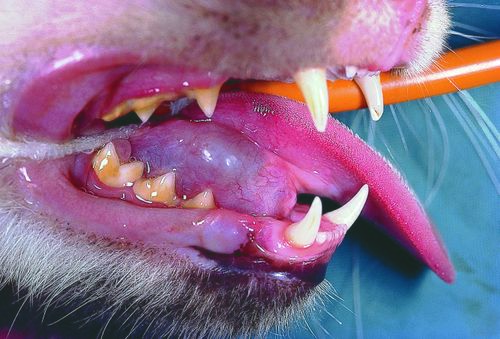Difference between revisions of "Veterinary Dentistry Q&A 10"
| Line 22: | Line 22: | ||
This pseudocyst is sometimes multilocular. | This pseudocyst is sometimes multilocular. | ||
| − | |l1= | + | |l1= |
|q2=What are the treatment options? | |q2=What are the treatment options? | ||
|a2= | |a2= | ||
| Line 30: | Line 30: | ||
Alternatively – or in addition – the polystomatic sublingual salivary gland can be resected, which is very difficult but fortunately only rarely necessary. | Alternatively – or in addition – the polystomatic sublingual salivary gland can be resected, which is very difficult but fortunately only rarely necessary. | ||
| − | |l2= | + | |l2= |
</FlashCard> | </FlashCard> | ||
Revision as of 22:52, 12 October 2011
| This question was provided by Manson Publishing as part of the OVAL Project. See more Veterinary Dentistry Q&A. |
This soft, fluid-filled, fluctuating swelling is fairly typical for a condition commonly seen in the cat, but also in the dog.
| Question | Answer | Article | |
| Name and define this condition, and explain its pathogenesis. | A ranula is a clinically descriptive term for a salivary mucocele that occurs specifically in the floor of the mouth and sublingually. Salivary mucoceles in the dog and cat are generally considered to be caused by extravasation of saliva, largely of unknown origin. Usually there is no history of trauma. Obstruction, simple transection of the duct, or trauma to glandular tissue does not cause a mucocele. Ligation of the duct causes atrophy of the gland involved. It is generally accepted that there is a lesion of the sublingual or mandibular salivary duct, or in one of the small ducts of the polystomatic sublingual salivary gland. Saliva leaks out and is not absorbed. This is irritating and causes the formation of a pseudocyst, lined by granulation tissue and macrophages. This pseudocyst is sometimes multilocular. |
[[|Link to Article]] | |
| What are the treatment options? | A ranula may be treated by intraoral marsupialization. An elliptical part of the ranula wall is excised. The edges are oversewn with a simple continuous suture, using thin synthetic absorbable suture material, to prevent premature closure. Alternatively, or if the above procedure is unsuccessful, surgical resection of the monostomatic sublingual and mandibular salivary glands on the affected side is performed. Alternatively – or in addition – the polystomatic sublingual salivary gland can be resected, which is very difficult but fortunately only rarely necessary. |
[[|Link to Article]] | |
